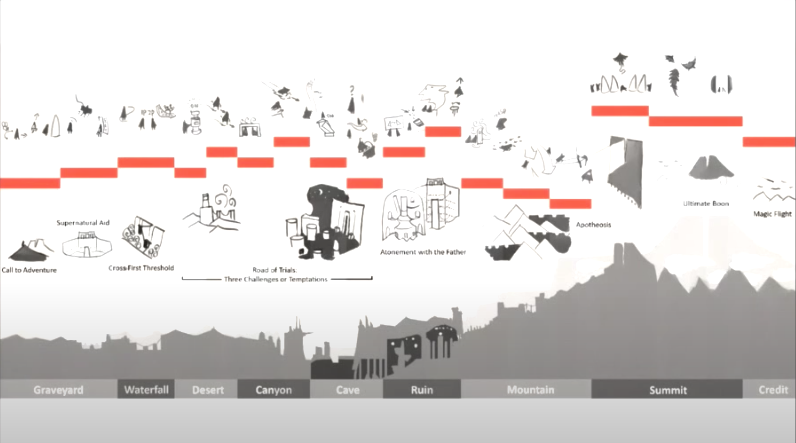1. Introduction
Most people agree that the eight art forms are Architecture, Sculpture, Painting, Music, Dance, Poetry, Film, and Television. As time passed, there was a more open acceptance of the categories, and a French film critic, Claude Beylie, stated that comics are the ninth art because of their pictorial storytelling [1]. Other than these, video games are not precisely identified as the ninth art, but some video games incorporate the performance of aesthetics from the Eight Forms of Art. In addition, what makes the video game unique compared to other forms of art is its Interactivity; with the evolution of the era, video games, as one of the most popular storytelling mediums, have succeeded in breaking into the public. Furthermore, the purpose of games has changed from being a single source of enjoyment to addressing societal issues and cultural diversity. For example, they can discuss relationships, mental health, and other social matters. Beautiful music, eye-catching graphics, and an original and abstract narrative style are all used in many cozy games to tell a gripping tale that makes the player stop and think. As for game designers, flow and immersion are crucial factors in judging games. This essay will mainly discuss how Gris and Journey provide players with a good flow and immersion experience. Gris and Journey are both independent adventure games. These two games have also won many significant awards in the gaming industry. Saying Gris and Journey is a cozy game because their theme is self-growth, and they further discuss the importance of belonging. They have no punishment mechanism, and their linear gameplay allows players to play at their own pace. This will make players feel less challenged and more immersed in the game environment, thus evoking a feeling of sombre and calmness [2]. They deeply connect with the player's emotions through stunning visuals and music and have a strong resonance with the player, which makes them a great deal more immersive.
2. A Brief Definition of Flow and Immersion
When playing a game, an evolving equilibrium between its challenge and the players' capacity to meet that challenge will make it “fun”. Flow can be described as deep fun. To ensure the flow experience is sustained, the relevant game activities must balance their difficulty with the player's ability[3].
According to definitions from scholars, immersion means a state of a person deeply engaged in an activity while feeling isolated from the present environment. Referring to games it’s a sense of fully taking part in the world of games [4]. Immersion experience appears when people watch films and TV shows (passive media) and play games (interactive media); unlike passive media, players play games as active participants instead of passive observers. Also, the emotions generated by interactivity while playing a game are more complex.
According to Huiberts, he concluded and compared the different classifications of Immersion by scholars. Classifying immersion makes the characteristics of this state clear. However, the classification by Ermi and Mäyrä is primarily the standard used in immersion. They examined the gameplay experience's elements to analyze immersion and classified immersion into sensory, challenge-based, and imaginative immersion (the SCI model)[4]. In this paper, it will analyze the game based on this model.
3. How Cozy Games Relate to Flow and Immersion
According to Wäppling et al., the cozy game is a tool for gamers to self-practice their game skills in a safe, abundant, and soft game environment to satisfy their curiosity and other needs [2]. Cozy games pay more attention to players’ motivation and emotional needs. They are slow-paced and let players immerse in exploring fun in mundanity by using simple operations, then provide them with a safe, emotional, warm-hearted experience. As the saying by Wäppling, cozy games are closely related to healthy games, which allow players to express love and compassion. Sometimes, they are light-hearted, healthy games that can tackle even the heaviest subjects [2]. Many cozy games focus on bringing the players back to themselves, making the players feel that the game characters resonate with them, just as games Gris and Journey, their stunning visuals and beautiful music are all about coziness, so through these play experiences related to self-expression, cozy games provide players with a unique flow and immersion experience.
3.1. Immersion and Flow from Games Visuals
The Gris game was designed and developed by a Spanish studio, Nomada Studios. It is a figurative therapeutic journey of a young girl named Gris. It’s also a realistic-themed, half-serious game that talks about depression. Like many mental illness patients, the protagonist in the game must change herself, which is reflected in the changing shape of her clothes. She must make herself strong enough to protect herself and break through difficulties.
Gris game has five colour theme stories, and five colours represent five stages of grief. Five Stages of Grief is a psychological model introduced by a Swiss-American psychiatrist, Elisabeth Kübler-Ross [5]. Each colour of the game closely connects to its storytelling. Gris Game Studio designed the game colours and soundtrack based on Three Centuries of Colour Scales, referencing the colours primarily used in specific notes. This theory states that when people hear different musical tunes, they feel some colours reflecting them. The studio used this theory in the game design to create synesthesia between the player and the game more rigorously. Each time the new colour stage is unlocked, more instruments are played, and the sound of the music becomes more layered. The richer the music shows, the more colours fill the protagonist's heart [6]. People, therefore, experience related emotions from visual colours and music through the game.
3.2. Immersion and Flow from Games Music
The article by Goosey discusses different hearing patterns of players listening to game music. To summarize, good game music will not only let players feel the message the music itself wants to convey but also allow players to have their understanding and thinking when they hear the music and have a stronger resonance with the game content, thus providing players with good auditory-evoked engagement. Such music will connect players tightly with imaginative immersion, where players not only experience the emotional message of the game itself but also extend other emotions based on the original emotional message (for example, the game conveys sadness, but players also feel anger) [7].
One thing showcases how the Journey game designer, Chen, attaches importance to the game's music design: he structured an emotional intensity graph (see Fig. 1) to guide the relationship between music and players’ emotions [7].

Figure 1: Emotional intensity graph [7].
When playing Journey, the clever design of the game music brings the player into the expected emotional atmosphere, making the interaction between the player and the game much more efficient.
The music in Journey uses several techniques to keep the player focused and engaged; for example, Music with a tight and heavy rhythm makes players feel sensory and challenge-based immersion. Chen, the author of the game, thinks the game's tone never lost a slight tinge of sadness. Therefore, the rhythm of the music is also subtly changing, and these musical changes make the players feel more shocked and sadder in the ruins of the scene [7]. The music of this game uses various instruments, and each instrument and its play have its unique role and arrangement. Each play can also subtly affect the emotions of the players.
3.3. Immersion and Flow from Games Narration
Gris uses visual symbols and metaphors to narrate the process of self-healing skillfully, and the game shows a storytelling way that progressively breaks each level. For example, in the first phase of Gris, the story environment changes from dull black and white (representing powerlessness and sadness) to red anger. After the protagonist's clothes change for the first time, she will break stones to vent anger, which is also one of the necessary processes to pass the level. In the green story, the protagonist meets and helps the partners in the forest, which are the factors that help her pass through the game, and the green story metaphors sociality.
The symbolism in Gris is the most essential part of the game, and these symbolic elements drive the development and change of the entire story. The protagonist's clothes are a symbol, the change of which means growth; the blackbird and eel symbolize the protagonist's plight, and the different environmental colours symbolize the five different emotions of depression. For example, in the final scene of Anger's story, a giant black bird blocks Gris's progress, and Gris must turn her clothes into square stones to fend it off. Along the way, gris also uses the wind blown by the giant bird to rise higher to pass the level, showing that difficulties can be obstacles that bother you or stepping stones to help you succeed. The life philosophy here allows more players to resonate emotionally with the protagonist.
This game represents the inner world of depressed people through a rich, elegant visual experience and game interaction. Its achievement is not only to make the public pay more attention to the mental illness group but also to reflect the different emotional states of people under the pressure of contemporary society, as well as the thoughts of those who want to break away from the shackles of pressure and reconcile with themselves.
4. Conclusion
This paper analyzes the relevant literature to summarize the internal relationship between flow, immersion, and cozy game design and takes the two cozy games, Gris and Journey, as examples. This paper finds that a good immersive experience is vital in game design, but some conditions inevitably cause teenagers to become addicted to online games. Extreme gaming has a more negative impact on people’s lives. When designing a game, especially for teenagers, game designers need to consider the positive game mechanics of games and the psychological health of these players. For example, the sense of flow is a harmonious psychological state in which the player is given challenges but does not exceed his ability. If the player has to buy a lot of equipment to complete the game, or if the difficulties are unbalanced, and some levels are so complicated that the player has to spend a lot of time and money to pass, the game design is poorly designed.
It is necessary to give semi-serious healing games more market opportunities. Further, suppose game designers make semi-serious games richer, more profound, and more educational in their audiovisual design, narrative design, and meaning so that players will have a lot of inspiration after the game. In that case, such games will increase the player's good immersive experience and reduce lousy addiction habits.



